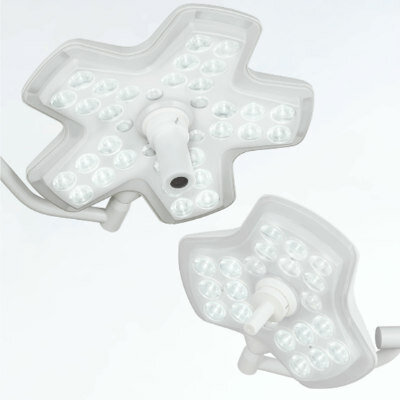New Medical Monitors Augment Clinical Use
|
By HospiMedica International staff writers Posted on 24 Apr 2019 |

Image: The new medical monitors were designed to meet international standards (Photo courtesy of Contec Americas).
A new range of medical-grade monitors combine image quality, performance, and safety for a wide variety of hospital and laboratory applications.
The Contec Americas (Melbourne, FL, USA) line of medical monitors currently includes seven displays designed for original equipment manufacturers (OEMs) that require versatile, long life solutions. The clinical displays range in size from 15" to 27" and include 5-wire resistive touch and projected capacitive touch (PCAP) options. Monitors in the Legacy group feature the standard 4:3 aspect ratio, in order to help manufacturers protect their existing investments as they transition to widescreen (16:9) format.
Conversely, the Modern line boasts a sleek, contemporary look, 16:9 widescreen aspect ratio, high brightness up to 350 nits, wide viewing angles of up to 178 degrees, and true-flat front, IP65 rating for easy cleaning and sanitation. All monitors in both groups meet digital imaging and communications in medicine (DICOM) part 14 image quality, as well as international standard for environmentally conscious design (IEC 60601) compliance to medical safety and performance standards.
“We have expanded our capabilities and reimagined our entire portfolio with the customer in mind,” said Brad Jens, executive vice president of Contec Americas. “Our new collection of monitors, panel PCs, all-in-one computers (AIOs), and embedded systems is purpose-built to the customer's specific needs. When combined with our suite of integration and support services, we are able to offer our customers a new level of partnership and support.”
“We leveraged our 30 years in the medical industry and solicited feedback from customers across many modalities to identify which features and functionality were most important,” said Jeannette Toews, director of displays at Contec Americas. “In addition to image quality and performance, which are critical to accurate diagnosis, we considered the functional requirements of the equipment and ease-of-use. I'm really proud of the result, which supports a wide range of applications in the life sciences, pharmaceutical, diagnostic, and imaging specialties.”
Historically, computer displays, like televisions, had an aspect ratio of 4:3 (width of the display screen to the height). For widescreen LCD monitors, the aspect ratio is generally 16:9, which is more suited for are viewing movies, playing games, and displaying multiple windows side by side. High definition (HD) and ultra HD also use a widescreen aspect ratio.
Related Links:
Contec Americas
The Contec Americas (Melbourne, FL, USA) line of medical monitors currently includes seven displays designed for original equipment manufacturers (OEMs) that require versatile, long life solutions. The clinical displays range in size from 15" to 27" and include 5-wire resistive touch and projected capacitive touch (PCAP) options. Monitors in the Legacy group feature the standard 4:3 aspect ratio, in order to help manufacturers protect their existing investments as they transition to widescreen (16:9) format.
Conversely, the Modern line boasts a sleek, contemporary look, 16:9 widescreen aspect ratio, high brightness up to 350 nits, wide viewing angles of up to 178 degrees, and true-flat front, IP65 rating for easy cleaning and sanitation. All monitors in both groups meet digital imaging and communications in medicine (DICOM) part 14 image quality, as well as international standard for environmentally conscious design (IEC 60601) compliance to medical safety and performance standards.
“We have expanded our capabilities and reimagined our entire portfolio with the customer in mind,” said Brad Jens, executive vice president of Contec Americas. “Our new collection of monitors, panel PCs, all-in-one computers (AIOs), and embedded systems is purpose-built to the customer's specific needs. When combined with our suite of integration and support services, we are able to offer our customers a new level of partnership and support.”
“We leveraged our 30 years in the medical industry and solicited feedback from customers across many modalities to identify which features and functionality were most important,” said Jeannette Toews, director of displays at Contec Americas. “In addition to image quality and performance, which are critical to accurate diagnosis, we considered the functional requirements of the equipment and ease-of-use. I'm really proud of the result, which supports a wide range of applications in the life sciences, pharmaceutical, diagnostic, and imaging specialties.”
Historically, computer displays, like televisions, had an aspect ratio of 4:3 (width of the display screen to the height). For widescreen LCD monitors, the aspect ratio is generally 16:9, which is more suited for are viewing movies, playing games, and displaying multiple windows side by side. High definition (HD) and ultra HD also use a widescreen aspect ratio.
Related Links:
Contec Americas
Channels
Critical Care
view channel
Light-Based Technology to Measure Brain Blood Flow Could Diagnose Stroke and TBI
Monitoring blood flow in the brain is crucial for diagnosing and treating neurological conditions such as stroke, traumatic brain injury (TBI), and vascular dementia. However, current imaging methods like... Read more
AI Heart Attack Risk Assessment Tool Outperforms Existing Methods
For decades, doctors have relied on standardized scoring systems to assess patients with the most common type of heart attack—non-ST-elevation acute coronary syndrome (NSTE-ACS). The GRACE score, used... Read moreSurgical Techniques
view channel
Minimally Invasive Endoscopic Surgery Improves Severe Stroke Outcomes
Intracerebral hemorrhage, a type of stroke caused by bleeding deep within the brain, remains one of the most challenging neurological emergencies to treat. Accounting for about 15% of all strokes, it carries... Read more
Novel Glue Prevents Complications After Breast Cancer Surgery
Seroma and prolonged lymphorrhea are among the most common complications following axillary lymphadenectomy in breast cancer patients. These postoperative issues can delay recovery and postpone the start... Read morePatient Care
view channel
Revolutionary Automatic IV-Line Flushing Device to Enhance Infusion Care
More than 80% of in-hospital patients receive intravenous (IV) therapy. Every dose of IV medicine delivered in a small volume (<250 mL) infusion bag should be followed by subsequent flushing to ensure... Read more
VR Training Tool Combats Contamination of Portable Medical Equipment
Healthcare-associated infections (HAIs) impact one in every 31 patients, cause nearly 100,000 deaths each year, and cost USD 28.4 billion in direct medical expenses. Notably, up to 75% of these infections... Read more
Portable Biosensor Platform to Reduce Hospital-Acquired Infections
Approximately 4 million patients in the European Union acquire healthcare-associated infections (HAIs) or nosocomial infections each year, with around 37,000 deaths directly resulting from these infections,... Read moreFirst-Of-Its-Kind Portable Germicidal Light Technology Disinfects High-Touch Clinical Surfaces in Seconds
Reducing healthcare-acquired infections (HAIs) remains a pressing issue within global healthcare systems. In the United States alone, 1.7 million patients contract HAIs annually, leading to approximately... Read moreBusiness
view channel
Philips and Masimo Partner to Advance Patient Monitoring Measurement Technologies
Royal Philips (Amsterdam, Netherlands) and Masimo (Irvine, California, USA) have renewed their multi-year strategic collaboration, combining Philips’ expertise in patient monitoring with Masimo’s noninvasive... Read more
B. Braun Acquires Digital Microsurgery Company True Digital Surgery
The high-end microsurgery market in neurosurgery, spine, and ENT is undergoing a significant transformation. Traditional analog microscopes are giving way to digital exoscopes, which provide improved visualization,... Read more
CMEF 2025 to Promote Holistic and High-Quality Development of Medical and Health Industry
The 92nd China International Medical Equipment Fair (CMEF 2025) Autumn Exhibition is scheduled to be held from September 26 to 29 at the China Import and Export Fair Complex (Canton Fair Complex) in Guangzhou.... Read more














